Solar Repowering: Simple Guide To Repowering Your Home With Solar

The term solar repowering is used to describe the practice of modernizing and improving already-in-place solar power plants to increase their output of usable electricity. Reviving the solar power plants entails adding state-of-the-art components to the pre-existing infrastructure.
Upgrading and improving preexisting solar power installations to increase efficiency, performance, and longevity is referred to as “solar repowering.” To maximize the efficiency and production of a solar power plant, it may be necessary to upgrade or replace some internal components or systems.
With the ever-increasing need for renewable power, solar repowering has emerged as an important, cost-saving method for getting the most out of existing solar systems.
Solar repowering strives to improve the operational efficiency and longevity of solar power plants by adding newer technologies, upgraded components, and advanced engineering processes.
There are many upsides to switching to solar energy. First, it allows us to make better use of our current land and grid connections, which means we can put that money and space to better use elsewhere.
Improvements in photovoltaic (PV) panels, tracking systems, and inverters, all made possible by solar technology, are just a few examples of how repowering can greatly increase energy output.
The Process of Solar Repowering
Solar repowering entails a series of measures designed to enhance the performance of already installed solar panels. The standard steps are as follows:
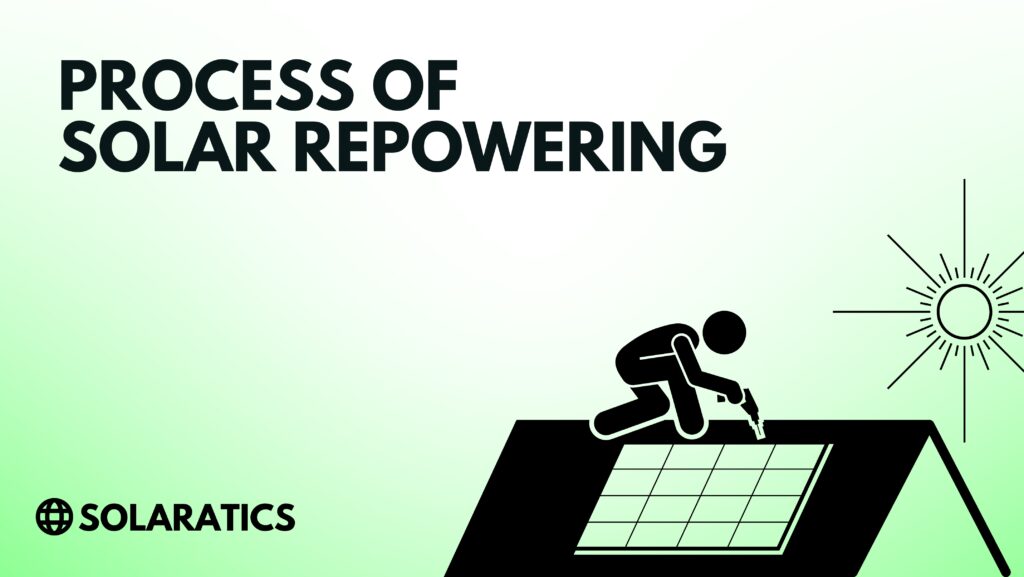
Analyzing And Judging:
An in-depth analysis of the current solar power plant is the first stage in solar repowering. This includes checking its status, reviewing its maintenance logs, and looking for flaws.
Collecting and analyzing data on energy production, equipment health, and system effectiveness.
Analysis Of Feasibility:
A feasibility study is performed based on the evaluation to weigh the benefits and costs of repowering. The analysis evaluates the project’s financial feasibility by calculating its payback time, rate of return, and predicted increase in energy production.
Designing A Power Switch:
After determining whether repowering is possible, a thorough strategy is great. To improve the efficiency of the solar power plant, the following measures have been mapped out.
It could mean upgrading to newer, more efficient parts, incorporating cutting-edge tech, or tweaking the system’s architecture.
Alterations And Substitutions:
Implementing the modifications and replacements described in the repowering plan constitutes the repowering process itself. Newer, more efficient photovoltaic (PV) modules could be installed, along with upgraded inverters.
And balance-of-system components, enhanced tracking systems, and better monitoring and control infrastructure.
Integrating And Testing The Whole System:
When the upgrades are complete, they incorporated into the preexisting solar power plant. The re-energized system is put through rigorous testing to guarantee its newfound capabilities.
Energy production, system efficiency, and the enhanced parts’ steadiness and dependability could all be checked during testing.
Installation And Initial Operation:
The reenergized solar power plant has passed all necessary tests and has a commission for use. To keep everything running smoothly and spot any problems early, we do routine monitoring and maintenance.
The benefits of the repowering project are verified through ongoing monitoring and analysis of collected data about the system’s operation.
Benefits of Solar Repowering
Existing solar power plants can gain efficiency, sustainability, and economic viability through solar repowering. Some significant benefits of switching to solar electricity include:
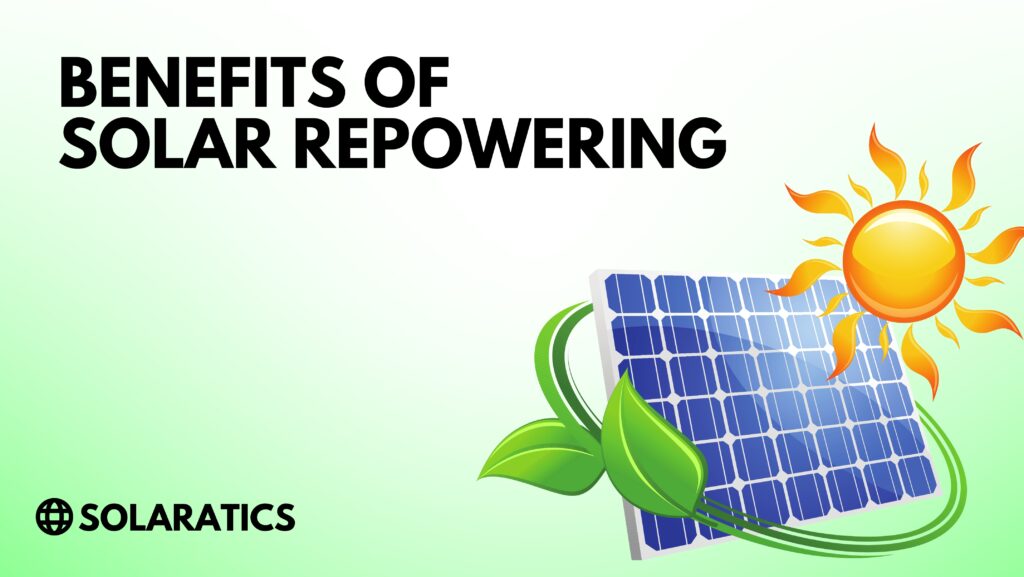
Generating More Power:
When a building is repowered, newer, more efficient technology and parts, such as more powerful photovoltaic (PV) modules and inverters, can be incorporated.
These upgrades have the potential to greatly boost the solar power plant’s energy generation capacity, allowing for greater amounts of clean, renewable energy to be produced.
Efficiency And Effectiveness Enhancements:
Solar repowering improves the effectiveness of a solar power plant by replacing worn-out or inefficient parts with newer models.
As a result, there is an increase in energy production, as well as a decrease in losses and an enhancement in system reliability.
Prolonged Survival:
The longevity of preexisting solar installations can be increased through repowering. The system’s operating life can be prolonged by upgrading important components and applying advanced maintenance techniques.
Which in turn reduces the need for premature replacement and improves return on investment.
Sustaining The Environment:
The viability of renewable power sources is improved through repowering. There is less need for new buildings, less land used, and fewer resources consumed when energy output from existing facilities is maximized through repowering.
It facilitates a cleaner and greener energy transition by reducing the carbon footprint of solar power generation.
Making Do With What We Have:
By reusing the land and grid connections already in place, solar repowering reduces the need for expensive new transmission lines and frees up valuable real estate.
This improves the efficacy and economy of the repowering process by maximizing the use of available resources.
Modern Technological Progress:
When repowering, it’s possible to use cutting-edge solar technology for the first time. Solar power facilities can benefit from state-of-the-art technology by upgrading to more efficient PV modules, better tracking systems, or improved monitoring and control systems.
Legal Requirements And Industry Standards:
New regulations and standards can be more easily met by solar power systems that have undergone repowering.
Repowering guarantees that current solar plants are compliant with and can continue functioning efficiently within the shifting regulatory landscape as renewable energy regulations develop.
Disadvantages of Solar Repowering
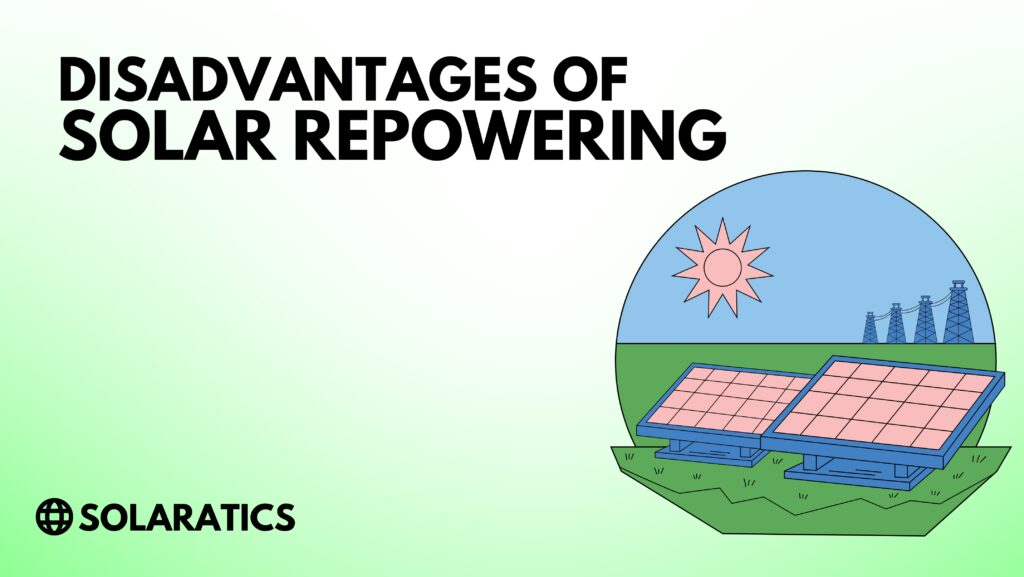
Although there are various benefits to solar repowering, there are also some potential drawbacks that should be taken into account. Some drawbacks to switching to solar energy are as follows:
Initial Capital Expenditures:
Repowering entails investing much upfront to upgrade or replace components within the current solar power plant. Particularly for large-scale solar projects.
The costs associated with acquiring new equipment, installing it, and integrating it into the system can be enormous. Some project owners or operators may struggle to afford these initial costs.
Interruptions To Business:
To replace or upgrade components, the solar power plant may need to be taken offline momentarily or in stages during the repowering process. Because of this, energy output may temporarily decrease or cease altogether.
Because of the potential impact on income, proper preparation needs to reduce the likelihood of power outages.
Harmony In Terms of Technology:
It can be difficult to make sure that the new parts of a solar power plant will work with the old ones while doing a repower. Depending on the nature of the upgrades.
The existing infrastructure may need to adapt to accommodate new equipment and technology. Repowering could be more expensive and time-consuming if incompatibility issues occur.
Potential for Enhancement is Minimal:
There may be constraints on how much a solar power plant can be recharged. The site’s physical limits, for instance, may hinder considerable gains in energy output.
The age or condition of the existing infrastructure may limit the effectiveness of renovations. The expenditures of repowering may not outweigh the possible benefits in such circumstances.
Taking Into Account The Environment:
It is vital to think about the environmental impact associated with the production, disposal, and recycling of replaced components when considering the sustainability of solar repowering as part of a larger renewable energy system.
To reduce the potential for environmental damage from the consumption of natural resources and energy during the production of new machinery, it is important to properly dispose of obsolete parts.
Modern Technological Progress:
Solar repowering has the potential advantage of combining cutting-edge technologies, but this also comes with its share of difficulties.
Even newly repowered systems may become obsolete in a few years due to the quick speed of technological improvements in the solar sector.
To guarantee long-term viability and prevent premature inefficiencies, project owners and operators must thoroughly examine the longevity and possibility of obsolescence of the upgraded components.
Constraints Imposed By-Laws And Permits:
It may be necessary to go through several regulatory and permitting hoops before a solar power facility may be repowered. There may be local regulations that must be met before a system can be upgraded or altered.
These further bureaucratic steps might add unnecessary time and expense to the repowering project.
Challenges And Limitations Of Solar Repowering
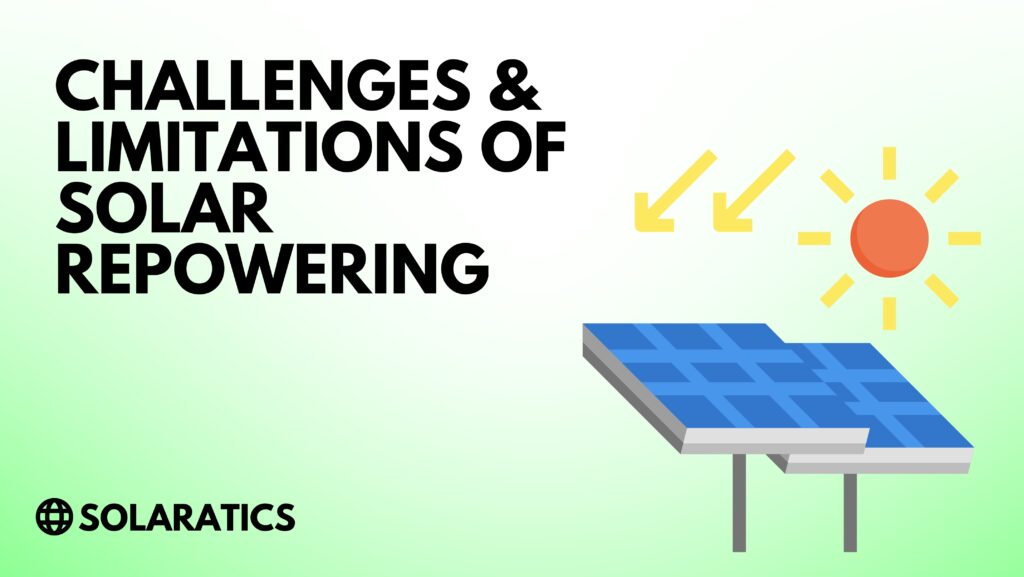
Despite its many advantages, solar repowering has its share of difficulties and constraints. Some of the major obstacles to solar repowering are as follows.
Acceptance And Combination:
There may be compatibility issues when adding new parts or technology to an existing solar power system. The reenergized parts must work in tandem with the preexisting electrical, data, and control networks without causing any disruptions.
Problems with compatibility or technical difficulties may develop, necessitating extra work in engineering and alterations to enable a smooth integration.
Cost-Effectiveness:
The total cost-effectiveness of the repowering project must consider, even though solar repowering has the potential to boost energy generation and extend the lifespan of a solar power plant.
Replacement parts, system upgrades, and engineering services can all have significant up-front expenditures.
Factors such as the age and condition of the existing plant, the availability of incentives or finance choices, and the anticipated energy generation gain all contribute to the repowering’s economic viability.
Limited Capacity Due To Age And Poor Layout:
Repowering is more or less successful depending on the age and condition of the current infrastructure. The extent to which older solar power facilities can repower may be constrained by design constraints.
Significant modifications may be impossible due to, for instance, a lack of structural capacity or insufficient electrical infrastructure.
It is essential to evaluate the constraints of the current plant to ascertain the likelihood of successful repowering.
Modern Technological Progress:
Repowering projects may be complicated by the solar industry’s fast-paced technological development. There is a risk of a technological gap developing between the upgraded parts and the rest of the system within a few years.
If you want to minimize inefficiencies or the need for repeated upgrades, you should give serious thought to the longevity and compatibility of repowered components.
Legal Requirements For Approval And Registration:
Regulations and permission requirements for solar repowering projects may vary by jurisdiction. Local approvals, permits, and restrictions can make the repowering procedure more difficult and time-consuming.
To have a compliant and trouble-free repowering project, it is crucial to negotiate these requirements successfully.
Installation of Solar Repowering
There is more than one way to go about installing the upgrades and adjustments needed to boost the efficiency and performance of an existing solar power plant as part of a solar repowering project. An outline of the setup procedure is as follows:
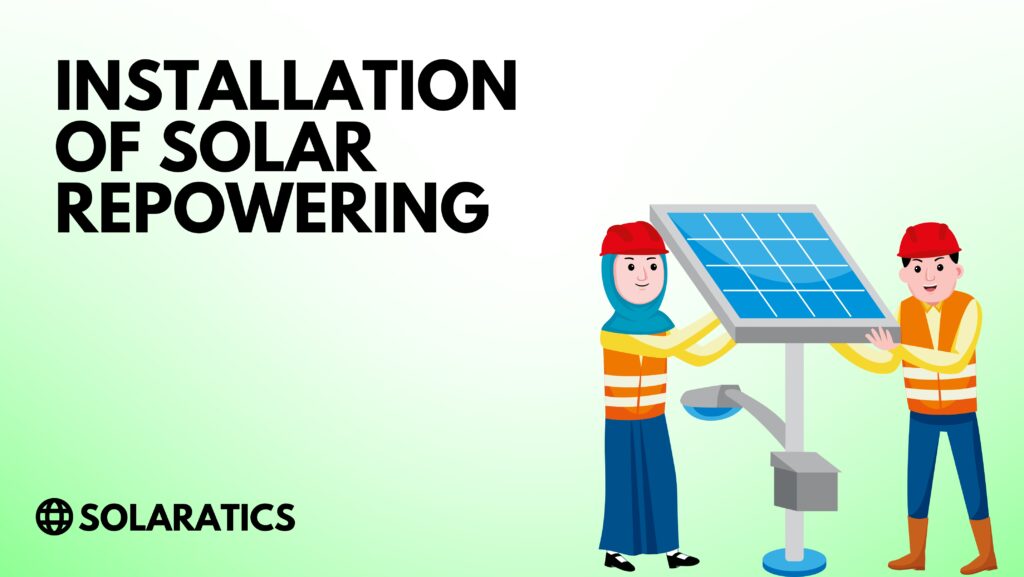
Preparation And Forethought:
Repowering goals inform the development of a comprehensive plan before installation. Specific improvements, replacements, or adjustments, as well as a timetable and resource allocation, are all part of the plan.
Buying Separate Parts:
New photovoltaic (PV) modules, inverters, tracking systems, and control systems are acquired as part of the repowering process. Selecting dependable vendors and guaranteeing interoperability with the current infrastructure are major priorities.
Upgrades And Substitute Parts:
Following standard safety measures, the old parts that have been marked for replacement or upgrading are taken out. A replacement part is put in its position with careful attention paid to its alignment, electrical connections, and mounting.
This could entail installing new PV modules, updating existing inverters, or incorporating cutting-edge tracking and monitoring equipment.
Wiring And System Integration:
The installed parts are incorporated into the system. Wiring, grounding, and compatibility with the solar power plant’s electrical system are all checked and double-checked before the electrical connections are made.
During the integration process, strict adherence to norms and regulations is maintained.
Verification And Activation:
After the new parts are installed and integrated, the reenergized system is put through rigorous testing to make sure it continues to operate and abides by all applicable safety standards.
Insulation resistance tests, voltage checks. Performance evaluations are only a few examples of the types of tests used to ensure the reliability of reenergized systems.
Upkeep And Performance Checks:
Maintenance and performance monitoring is necessary after solar repowering installation. Energy production, system efficiency, and component performance track using cutting-edge monitoring systems.
The long-term dependability and performance of the repowered system ensure the establishment of cleaning, inspection, and maintenance programs regularly.
Conclusion
By modernizing and increasing the efficiency of current solar power plants, solar repowering provides substantial benefits. Solar repowering increases energy production, enhances performance, lengthens the system’s lifespan, and decreases costs through assessment, design, and installation.
To maximize solar energy’s potential and speed up the global shift to clean and sustainable power sources, solar repowering plays a critical role by combining innovative technologies and improving current infrastructure.
Careful planning and execution can assist in overcoming limits including high upfront costs, significant disruptions to operations, and emerging technologies.
Repowering with solar allows us to make better use of our current infrastructure while also reducing our environmental footprint, meeting all applicable requirements, and benefiting from the newest technological developments in solar energy.
Also Read: Solar Wires Types & Choosing the Right Photovoltaic Solar Wires (Updated)
